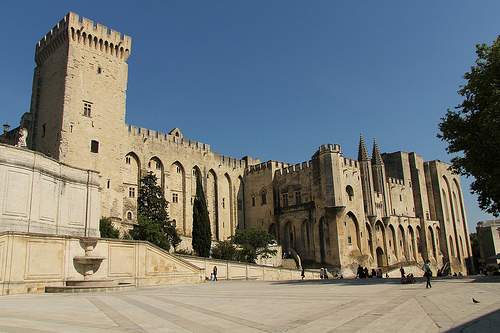|
|
|
|
|
| |
 |

Suivante >>
Retour sur la galerie photo |
| |
Palais des Papes 05/06/2013 17h20
A last look at the Palais des Papes before going downstairs under this square where the huge underground car park is located.
Palais des Papes
The Palais des Papes is an historical palace in Avignon, southern France, one of the largest and most important medieval Gothic buildings in Europe. One time fortress and palace, the papal residence was the seat of Western Christianity during the 14th century. Six papal conclaves were held in the Palais, leading to the elections of Benedict XII in 1334, Clement VI in 1342, Innocent VI in 1352, Urban V in 1362, Gregory XI in 1370 and Antipope Benedict XIII in 1394.
The Palais is actually made up of two buildings: the old Palais of Benedict XII which sits on the impregnable rock of Doms, and the new Palais of Clement VI, the most extravagant of the Avignon popes. Not only is the final combination the largest Gothic building of the Middle Ages, it is also one of the best examples of the International Gothic architectural style. The construction design was the work of two of France’s best architects, Pierre Peysson and Jean du Louvres and the lavish ornamentation was the work of two of the best students of the School of Siena (Italy), Simone Martini and Matteo Giovanetti.
Due to its immense size, the Palais was also the place where the general organisation of the Church began to change. It facilitated the centralisation of services and the adaption of operations in order to suit the needs of the papacy, creating a truly central administration for the Church. The strength of the Curia (Church administration), 200 at the end of the 13th century, surpassed 300 at the beginning of the 14th century and reached 500 people in 1316. To this was added over 1,000 lay officials working within the Palais.Despite this, the Palais became obsolete when the papacy found it necessary to return to Rome. The hope of reuniting Latin and Orthodox Christians, along with the achievement of peace in the Papal States in Italy, made the case of returning stronger. Added to that was the strong conviction of both Urban V and Gregory XI that the seat of the papacy could only be the tomb of St Peter. Despite strong opposition from the Court of France and the College of Cardinals, both popes found the means to return to Rome, the first, on 30 April 1362, the second on 13 September 1370. This time, the return was absolut.In the following centuries, the Palais lost all of its former glory, despite it serving as the seat of two anti-popes and many cardinals. It retained, however, a “work of destruction” aspect that French poets and writers have referred to over the centuries, with its powerful sense of beauty, simplicity, grandeur and immortality.
[ Source: Wikipedia – Palais des Papes ]

Photo mise en ligne par : Meteorry - Voir cette photo sur flickr
Date de la photo : 05 juin 2013
Lieu : Avignon, Vaucluse | Provence-Alpes-Côte d'Azur - France 7541
Autres photos pour ce lieu : Avignon               
Voir toutes les photos pour "Avignon"
|
| |
|
| |
|
| |
|
|
|
|
| |
|
| |
|
|
|
| |
|
| |
-t.jpg) |
|
|
| |
|
|
|
| |
Provence-Alpes-Côte d'Azur |
| |
 |
| |
|
| |
|
|
 Tags les plus aimés Tags les plus aimés |
| |
Le Pont du Gard, Côte d'Azur, Cigale, Hôtel Crillon le Brave (Relai & Château), Le Verdon, Le Luberon, Le Mont-ventoux, Lavande, Moulins de Provence, kartpostal, Abbaye de Montmajour, Cathédrale Saint-Trophime d'Arles, Le Palais des Papes, Abbaye de Sénanque, MuCEM - Musée des civilisations de l'Europe et de la Méditerranée, Dentelles de Montmirail, Théâtre Antique d'Orange, Cathédrale Saint-Sauveur, HÔTEL RESTAURANT DU LACHENS, Paysages de Provence |
| |
|
| |
|
|